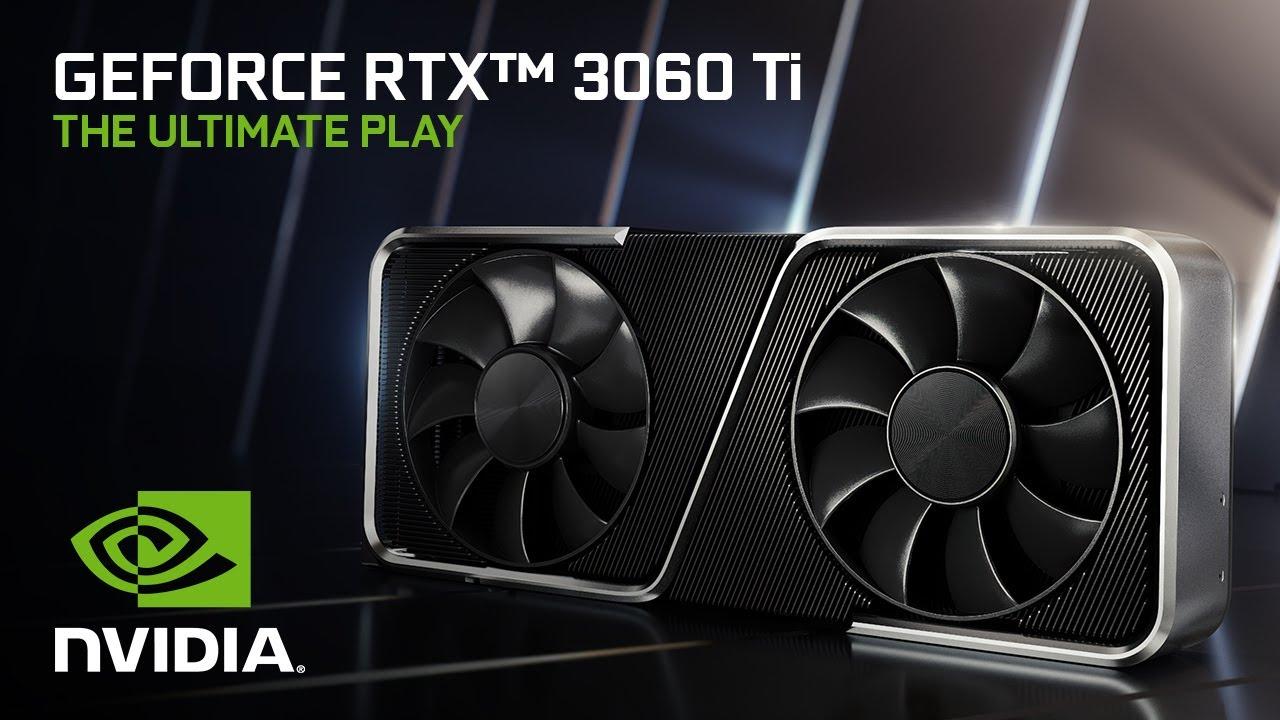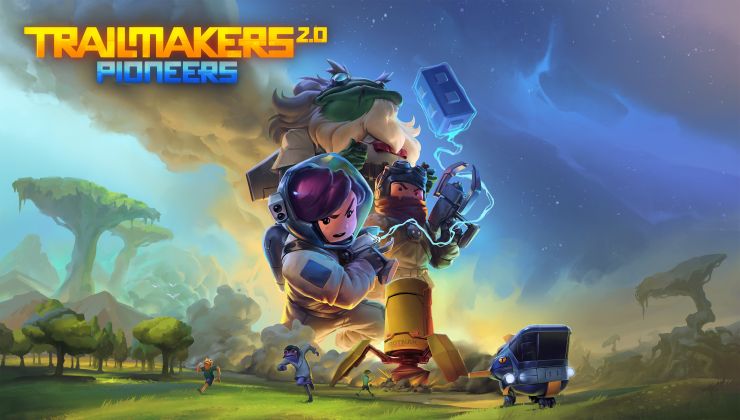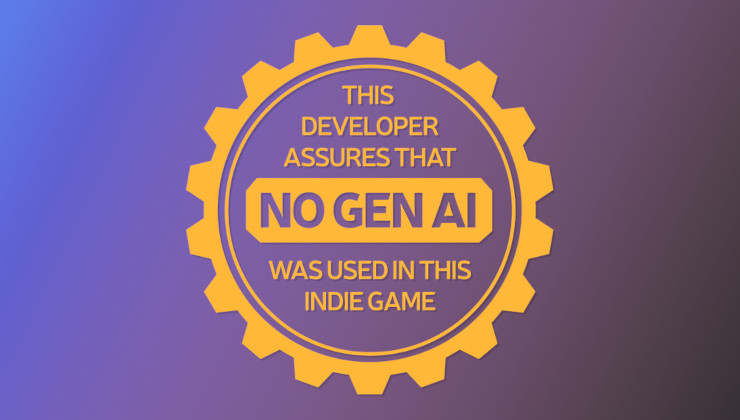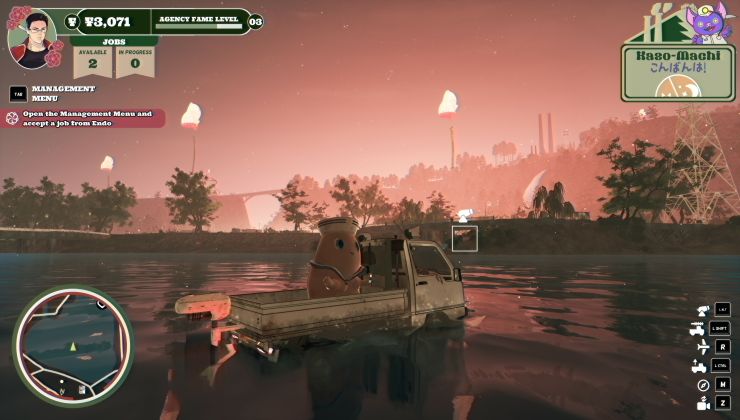NVIDIA have revealed the GeForce RTX 3060 Ti officially today, along with a release date of December 2 and it sounds like quite an awesome card.
Hitting performance levels (and above!) comparable to the RTX 2080 SUPER, which for the price is absolutely amazing at $399 / £369 which is far less than the 2080 SUPER. When it becomes available on December 2 this will be as custom boards including stock-clocked and factory overclocked models from various vendors as well as a Founders Edition direct from NVIDIA.
Want some specs? Here's a comparison between the models of the 3000 series:
| GEFORCE RTX 3090 |
GEFORCE RTX 3080 |
GEFORCE RTX 3070 |
GEFORCE RTX 3060 Ti |
||
|---|---|---|---|---|---|
| GPU Engine Specs: | NVIDIA CUDA® Cores | 10496 | 8704 | 5888 | 4864 |
| Boost Clock (GHz) | 1.70 | 1.71 | 1.73 | 1.67 | |
| Memory Specs: | Standard Memory Config | 24 GB GDDR6X | 10 GB GDDR6X | 8 GB GDDR6 | 8 GB GDDR6 |
| Memory Interface Width | 384-bit | 320-bit | 256-bit | 256-bit | |
| Technology Support: | Ray Tracing Cores | 2nd Generation | 2nd Generation | 2nd Generation | 2nd Generation |
| Tensor Cores | 3rd Generation | 3rd Generation | 3rd Generation | 3rd Generation | |
| NVIDIA Architecture | Ampere | Ampere | Ampere | Ampere | |
| PCI Express Gen 4 | Yes | Yes | Yes | Yes | |
| NVIDIA G-SYNC | Yes | Yes | Yes | Yes | |
| Vulkan RT API, OpenGL 4.6 | Yes | Yes | Yes | Yes | |
| HDMI 2.1 | Yes | Yes | Yes | Yes | |
| DisplayPort 1.4a | Yes | Yes | Yes | Yes | |
| NVIDIA Encoder | 7th Generation | 7th Generation | 7th Generation | 7th Generation | |
| NVIDIA Decoder | 5th Generation | 5th Generation | 5th Generation | 5th Generation | |
| Display Support: | Maximum Digital Resolution | 7680x4320 | 7680x4320 | 7680x4320 | 7680x4320 |
| Standard Display Connectors | HDMI 2.1, 3x DisplayPort 1.4a | HDMI 2.1, 3x DisplayPort 1.4a | HDMI 2.1, 3x DisplayPort 1.4a | HDMI 2.1, 3x DisplayPort 1.4a | |
| Multi Monitor | 4 | 4 | 4 | 4 | |
| HDCP | 2.3 | 2.3 | 2.3 | 2.3 | |
| Founders Edition Card Dimensions: | Length | 12.3" (313 mm) | 11.2" (285 mm) | 9.5" (242 mm) | 9.5" (242 mm) |
| Width | 5.4" (138 mm) | 4.4" (112 mm) | 4.4" (112 mm) | 4.4" (112 mm) | |
| Slot | 3-Slot | 2-Slot | 2-Slot | 2-Slot | |
| Founders Edition Thermal Power Specs: | Maximum GPU Temperature (in C) | 93 | 93 | 93 | 93 |
| Graphics Card Power (W) | 350 | 320 | 220 | 200 | |
| Required System Power (W) (2) | 750 | 750 | 650 | 600 | |
| Supplementary Power Connectors | 2x PCIe 8-pin (adapter to 1x 12-pin included) |
2x PCIe 8-pin (adapter to 1x 12-pin included) |
1x PCIe 8-pin (adapter to 1x 12-pin included) |
1x PCIe 8-pin (adapter to 1x 12-pin included) |
As long as you're not going for 4K gaming, the GeForce RTS 3060 Ti seems like a winner, and would likely be exactly what I would be going for if I was going to be building a system. At 1440p and 1080p gaming, it seems ideal. NVIDIA drivers generally have good Linux support too, and we expect NVIDIA to have a fresh driver up either today or tomorrow to formally add support for it on Linux - like they always do with a new GPU release. We're never left waiting around.

Direct Link
Going by Phoronix benchmarks on Linux, it seems like performance winner. I get that technology moves on quickly but even so, it still slightly amazes me just how much performance and price has come along with cards like this.
The real question is: just how fast will stock vanish this time? It may be releasing on December 2, doesn't mean many people will actually be able to get one though like the last few new GPU release.
If you do buy one, NVIDIA are throwing in one whole year of GeForce NOW Founder membership too which is open to both new and existing GFN customers to sweeten the deal. With their plans to actually support Linux with GFN in the browser, that sounds good.
NVIDIA still doesn't support re-projection for use in VR, right?From what I understand, they have the vulkan compute extensions for it, but not the low-latency, high priority driver path to make it actually usable.
NVIDIA still doesn't support re-projection for use in VR, right?You know, what? I think AMD drivers do? And if that's the case, that'd explain why others were saying that Elite Dangerous runs fine on Linux (Not that I can run it in Linux until someone writes up a scripting engine equivalent of the Thrustmaster Warthog has in Windows, as I now use that rather heavily.)
NVIDIA still doesn't support re-projection for use in VR, right?From what I understand, they have the vulkan compute extensions for it, but not the low-latency, high priority driver path to make it actually usable.
That's my understanding as well. Since I'm currently using a 1080 Ti and pretty happy with the general performance (though not the quirks), the only reason for me to upgrade is to fix the re-projection stutter I get in VR. If NVIDIA still hasn't "fixed" that under Linux though, there's not much point in a new card, no matter how good the bang-for-the-buck is - for me anyway.
That said, even if this new green card seems well priced, I'm finally about to quit using nvidia by christmas for AMD.
YAY!
Good luck getting a 6800(XT)/30X0 by XMas without paying double the MSRP xD
Last edited by poisond on 1 Dec 2020 at 6:39 pm UTC
That said, even if this new green card seems well priced, I'm finally about to quit using nvidia by christmas for AMD.
YAY!
Good luck getting a 6800(XT)/30X0 by XMas without paying double the MSRP xD
Quite the same for all next gen GPU. Team Green's GPUs, in the RTX 30x0 series, are not easier to find or cheaper, atm.
Not sure it's going to be better with this one either. Better wait for January... Maybe.
Last edited by Mohandevir on 1 Dec 2020 at 7:07 pm UTC
There are few demanding AAA's on Linux. Most of my library works on my second hand 970 i bought for 180 € in 2016. When i will buy metro exodus i will let some graphic options down and maybe play it again if i get a better graphic card.Ha, I am the exact opposite, if I can't get playable frame rates at max resolution / settings, I will upgrade.
Borderlands 2 runs better at 720P but is kinda dead now and Alien Isolation too runs at 720P.
So i'll wait more.
Granted with my monitor being 3840x1200@144hz, I may need to upgrade to either the 3080 or 6800 XT soon enough.
If not, no thanks, wake me up when AMD 6700 is released...
As long as you're not going for 4K gaming, the GeForce RTS 3060 Ti seems like a winner, and would likely be exactly what I would be going for if I was going to be building a system.
Is there still a reason to go for NVidia rather than AMD these days? I am shopping around for a new system too, but have basically ruled out NVidia, because AMD seems to be the much better deal these days, and getting rid of their proprietary driver rubbish is an added plus.
Also note, that apparently vkd3d-proton performance with Nvidia is not good, unlike with AMD. Phoronix tests don't really cover vkd3d-proton and dxvk in general, meaning those benchmarks don't tell the real story you'll be experiencing if you are using Wine / Proton, which is potentially a big amount of games. This will become more and more critical if there will be more games using DX12, which unfortunately is the current trend.
The real issue now is availability. I suspect there won't be any new cards available until next year.
Is there still a reason to go for NVidia rather than AMD these days? I am shopping around for a new system too, but have basically ruled out NVidia, because AMD seems to be the much better deal these days, and getting rid of their proprietary driver rubbish is an added plus.
I don't think there is any reason to use it for gaming on Linux these days. The only ones who might have a strong reason to use Nvidia on Linux are those who are stuck with something that's using CUDA lock-in and can't easily migrate from it.
Last edited by Shmerl on 2 Dec 2020 at 4:45 am UTC
I think there will be demanding games that will benefit from high end cards even on 2560x1440, not just on 4K. After some analysis, I'm planning to get RX 6800 XT to be able eventually to play Cyberpunk 2077 on high settings with 2560x1440.I think I've decided I am going to attempt an AMD RX6800 XT as well. The big question is... where can you get one? :P
Also note, that apparently vkd3d-proton performance with Nvidia is not good, unlike with AMD. Phoronix tests don't really cover vkd3d-proton and dxvk in general, meaning those benchmarks don't tell the real story you'll be experiencing if you are using Wine / Proton, which is potentially a big amount of games. This will become more and more critical if there will be more games using DX12, which unfortunately is the current trend.
The real issue now is availability. I suspect there won't be any new cards available until next year.
Is there still a reason to go for NVidia rather than AMD these days? I am shopping around for a new system too, but have basically ruled out NVidia, because AMD seems to be the much better deal these days, and getting rid of their proprietary driver rubbish is an added plus.
I don't think there is any reason to use it for gaming on Linux these days. The only ones who might have a strong reason to use Nvidia on Linux are those who are stuck with something that's using CUDA lock-in and can't easily migrate from it.
I think I've decided I am going to attempt an AMD RX6800 XT as well. The big question is... where can you get one? :P
I'm waiting for Sapphire to release their Pulse model of RX 6800 XT. But I don't think it will be available anywhere until next year at least.
Is there still a reason to go for NVidia rather than AMD these days? I am shopping around for a new system too, but have basically ruled out NVidia, because AMD seems to be the much better deal these days, and getting rid of their proprietary driver rubbish is an added plus.
When looking on ProtonDB for some game compatibilities, I found that, when people mentionned graphical bugs/artifacts, most of the time they had an AMD GPU. People with similar spec, but on nVidia, usually did not encounter these issues.
Also, I think that there is an additional parameter to specifiy when using an AMD GPU for some games.
Just my 2 cents though, I didn't go into full-fledged statistical analysis on that, it's just some kind of trend I noticed
Also note, that apparently vkd3d-proton performance with Nvidia is not good, unlike with AMD. Phoronix tests don't really cover vkd3d-proton and dxvk in general, meaning those benchmarks don't tell the real story you'll be experiencing if you are using Wine / Proton, which is potentially a big amount of games. This will become more and more critical if there will be more games using DX12, which unfortunately is the current trend.
DXVK experience/performance is good on NVidia ;)
Phoronix did a few DXVK tests, maybe you missed them:
https://www.phoronix.com/scan.php?page=article&item=rx6800-more-performance&num=4
I have no idea how you come to the conclusion that NVidia performs worse for DXVK titles when all evidence points to the opposite.
I don't own any DX12 titles yet, but maybe you have some benchmarks to support your claims?
You can also consult https://www.protondb.com/stats by GPU (spoiler, NVidia does better)
Also there wasn't any hardware available that had comparable performance to NVidia until now so that statement is kind of silly since it was impossible get as good performance on AMD. I could say how bad the 5700XT experience was compared to a 1080TI ... but that would make as much sense as your claim.
The real issue now is availability. I suspect there won't be any new cards available until next year.Yeah, by the time I've watched a review and read the phoronix article all 6800XTs were gone >.< Supply must've lasted mere seconds and no restock in my country since then.
Is there still a reason to go for NVidia rather than AMD these days? I am shopping around for a new system too, but have basically ruled out NVidia, because AMD seems to be the much better deal these days, and getting rid of their proprietary driver rubbish is an added plus.
I don't think there is any reason to use it for gaming on Linux these days. The only ones who might have a strong reason to use Nvidia on Linux are those who are stuck with something that's using CUDA lock-in and can't easily migrate from it.
NVENC for in home streaming, streaming and generally people who do a lot of video encoding. Because AMDs HW encoder is horrid in comparison (quality, performance)
Also couldn't get VR working on AMD without compiling a specific git mesa version. Even then it was a stuttery and unstable mess - for a card that was released over a year prior. Great experience ^^
As long as you're not going for 4K gaming, the GeForce RTS 3060 Ti seems like a winner, and would likely be exactly what I would be going for if I was going to be building a system.
Is there still a reason to go for NVidia rather than AMD these days? I am shopping around for a new system too, but have basically ruled out NVidia, because AMD seems to be the much better deal these days, and getting rid of their proprietary driver rubbish is an added plus.
Ray tracing is coming, and it is to be expected that it will be ubiquitous real fast now. And you can check on gamer nexus bench for RT on 3060TI: https://www.youtube.com/watch?v=t9H2PfYDFok which will tell you why you should go nvidia from that point (for gaming at least)... And the more modern the game/RT implem, the worst it is. RT is coming to Linux too when you see all the moves around vulkan ray tracing etc. I don't know if dlss will come to linux/dxvk etc too, I certainly hope so (and I suspect from leaks dlss 3.0 is near and will bring dlss to most games...), and then this will be a massive burial.
As such, unless you plan to change card in 1 year, you should not look at raster performance, but at more interesting RT, and nvidia utterly dominates here, a 400€ card is better than the 700€ card for AMD. Also, AMD MSRP is a total lie, and even when they are in stock, I don't expect to see any card at less than 100€ more than msrp or not before a very long time, making it not much of a sweet deal in the end. At least nvidia has founder editions to control the price.
Also, whether we like it or not (I don't but well), CUDA is here to stay too... And CUDA is Nvidia. Now, the experience is certainly better than opencl overall, so I'm not gonna blame anyone for staying on CUDA/Nvidia either. Just it is a pain in the ass to setup sometimes... That is smthg I'd love for Nvidia to open source more the framework so we can use/install it more easily.
Now, AMD has open source driver, which is a big pro, and I wish Nvidia could finally open at least the kernel module. But without RT perf to back it, AMD cards will become expensive open source paperweights before long, and for compute, it lacks CUDA, so is basically non existant.
Last edited by 3zekiel on 2 Dec 2020 at 12:45 pm UTC
[...] I have no idea how you come to the conclusion that NVidia performs worse for DXVK titles when all evidence points to the opposite.I can't link to benchmarks, but I can point you at [user YoRHa-2B](https://www.gamingonlinux.com/profiles/7078) - who actually works on DXVK - and their comments regarding NVIDIA, such as:
I don't own any DX12 titles yet, but maybe you have some benchmarks to support your claims? [...]
["On Nvidia though? Complete dogshit. Horizon Zero Dawn runs significantly slower on a 1080 Ti than it does on my RX 480 (...)"](https://www.gamingonlinux.com/2020/11/direct3d-12-to-vulkan-layer-vkd3d-proton-has-a-20-release/comment_id=192874)
and
["(vkd3d) has some cursed workarounds for Nvidia driver/hardware limitations to improve stability"](https://www.gamingonlinux.com/2020/11/direct3d-12-to-vulkan-layer-vkd3d-proton-has-a-20-release/comment_id=192842)
I'll let you look around for yourself for a bigger picture, but the impression I get as well, is that NVIDIA's drivers have issues with DXVK that don't exist with AMD.
You can also consult https://www.protondb.com/stats by GPU (spoiler, NVidia does better)By 6% for Platinum ratings and 1% for Silver and Bronze. With the disparity between the amount of AMD and NVIDIA user, that's pretty much within noise ratio.
Now, back to our regularly scheduled flame-war :P
Last edited by Cybolic on 2 Dec 2020 at 3:07 pm UTC
Ray tracing is coming, and it is to be expected that it will be ubiquitous real fast now. And you can check on gamer nexus bench for RT on 3060TI: https://www.youtube.com/watch?v=t9H2PfYDFok which will tell you why you should go nvidia from that point (for gaming at least)... And the more modern the game/RT implem, the worst it is. RT is coming to Linux too when you see all the moves around vulkan ray tracing etc. I don't know if dlss will come to linux/dxvk etc too, I certainly hope so (and I suspect from leaks dlss 3.0 is near and will bring dlss to most games...), and then this will be a massive burial.
As such, unless you plan to change card in 1 year, you should not look at raster performance, but at more interesting RT, and nvidia utterly dominates here, a 400€ card is better than the 700€ card for AMD. Also, AMD MSRP is a total lie, and even when they are in stock, I don't expect to see any card at less than 100€ more than msrp or not before a very long time, making it not much of a sweet deal in the end. At least nvidia has founder editions to control the price.
RT won't be the standard until you have RT capable hardware in all your GPU tiers. Either way, we are on Linux and to the date you can only play two games on Linux with RT (AFAIK). And the DLSS situation is just worst (and lets keep away future "improvements" predictions). From a Linux gaming experience, you should definitely take a look on the raster performance as this are the only benchs you can get on our platform. In the end, DLSS and RT are gimmick features for Linux.
Also, whether we like it or not (I don't but well), CUDA is here to stay too... And CUDA is Nvidia. Now, the experience is certainly better than opencl overall, so I'm not gonna blame anyone for staying on CUDA/Nvidia either. Just it is a pain in the ass to setup sometimes... That is smthg I'd love for Nvidia to open source more the framework so we can use/install it more easily.
As you implies, CUDA is just important for a minority of the gaming market, just like VR capabilities are.
Ray tracing is coming, and it is to be expected that it will be ubiquitous real fast now.
But will it come before 2018 aka Wayland in production use? Oh, wait, it's already 2020! Using a 27' 4k screen, I already depend on it in production for fractional scaling.
AMD cards will become expensive open source paperweights before longUntil they do not offer acceleration in XWayland, NVidias cards are 'expensive closed source' paperweights for Games right NOW for me. Ofc, your situation can be different (so this is not to answer Kimyrielle's original question about there being any use, but rather to comment the fallacies in reply to it).
Even putting OSS ideals aside, what I see is NVidias driver stack more and more failing to enable a modern Linux desktop experience, not for being badly implemented, but for being at odds with the Linux model architecturally. Just look at the EGLStreams mess. If they want to address these problems, this would require NVidia to rewrite large parts of their driver in a way more compatible with Linux's model, and therefore lose the advatages they get from sharing large parts of the codebase with Windows.
They were the best on the market in the early 2010s, but AMD has integrated much better into the Linux ecosystem and is now offering the superior driver situation for general desktop use and Intel always had a good practice for Linux drivers and upstreaming graphics stuff. I'm looking forward to them joining the dGPU market.
Ray tracing is coming, and it is to be expected that it will be ubiquitous real fast now.
But will it come before 2018 aka Wayland in production use? Oh, wait, it's already 2020! Using a 27' 4k screen, I already depend on it in production for fractional scaling.
AMD cards will become expensive open source paperweights before longUntil they do not offer acceleration in XWayland, NVidias cards are 'expensive closed source' paperweights for Games right NOW for me. Ofc, your situation can be different (so this is not to answer Kimyrielle's original question about there being any use, but rather to comment the fallacies in reply to it).
Even putting OSS ideals aside, what I see is NVidias driver stack more and more failing to enable a modern Linux desktop experience, not for being badly implemented, but for being at odds with the Linux model architecturally. Just look at the EGLStreams mess. If they want to address these problems, this would require NVidia to rewrite large parts of their driver in a way more compatible with Linux's model, and therefore lose the advatages they get from sharing large parts of the codebase with Windows.
They were the best on the market in the early 2010s, but AMD has integrated much better into the Linux ecosystem and is now offering the superior driver situation for general desktop use and Intel always had a good practice for Linux drivers and upstreaming graphics stuff. I'm looking forward to them joining the dGPU market.
For XWayland, Fedora team is working on it so you can use it without having to go through a copr. And yes, I agree Nvidia defo has some rough egdes. Wayland is not very useful for now, but it is coming to be. For the discharge of Nvidia, necessary code is in X11 git, but there is just no release due to Xorg becoming basically abandonware, so to set it up you have to go through copr or whatever the equivalent is on *deb distros to get it working. That being said, you also need to do the same for AMD radv/ACO drivers so ...
On other answer about RT not becoming more and more important, just look at what gamers ask on various streams, and look at how many games now support or make full use of it. For linux, it mostly needs to be enabled in vkd3d/dxvk, where Khronos made the implem fit that special need, so I expect it will come real soon, making it not much of a gimmick. I don't expect Khronos would waste time creating API that way if it was not coming - most likely there is stadia push too. DLSS is another discussion certainly, it's true I should not include it in the comparison yet.
More generally, For RT becoming ubiquitous, now all GPUs which roll out, including that of consoles will most likely be equipped. So the prerequisites are here. And it really improves stuff so...
On the other side, I'm definitely waiting on Intel new card before buying anything. Because Intel driver + potentially good RT perf, now, that would beat Nvidia all the way. Intel igpu, from a desktop/driver perspective is indeed the best in class, never had to tinker, pretty much never had any strange bugs, no kernel version limitation, full support for gpu virtualisation in consumer hw, which is a killer feature for me. Intel is certainly a perfect game on sw support, and are truly the superior option when it comes to Linux workstation (and since my machine need to do both game and work). Just hope their dgpu is good in term of hw too :)
Is there still a reason to go for NVidia rather than AMD these days?
It really depends. If you need a stable driver you won't have to uninstall/rebuild manually after each kernel update and you need cuda for some computation (3d rendering for example) Nvidia is sadly the way to go, no matter how pissed I am the whole Wayland deal has not been sorted out.
But if you need something for gaming and everyday Linux desktop AMD can be a nice option.







 1 Dec 2020
1 Dec 2020







 How to set, change and reset your SteamOS / Steam Deck desktop sudo password
How to set, change and reset your SteamOS / Steam Deck desktop sudo password How to set up Decky Loader on Steam Deck / SteamOS for easy plugins
How to set up Decky Loader on Steam Deck / SteamOS for easy plugins
See more from me